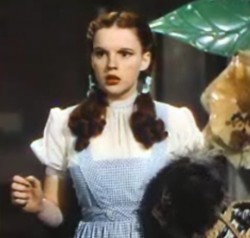Leadership is about going somewhere. Whether you are facing challenges as a result of changes in the economy, new opportunities because of advances in technology, or already have a good idea you want to implement, these five lessons can make the difference between a successful outcome and a false start. The good news is: you already learned them in kindergarten. All you need to do is remember to use them.
The lesson of Alice and the Cheshire Cat: If you don’t know where you’re going, it doesn’t matter what path you take.

Alice: Would you tell me, please, which way I ought to go from here?
The Cat: That depends a good deal on where you want to get to
Alice: I don’t much care where.
The Cat: Then it doesn’t much matter which way you go.
Alice: …so long as I get somewhere.
The Cat: Oh, you’re sure to do that, if only you walk long enough.
“Where are you going? What is your vision?” These are the first questions to ask before you begin any initiative, whether it is planning a large change effort or just a simple project.
In organizations where people share a common vision, daily activities have meaning and people are able to make decisions based on where they want to be in the future.
When you focus on the path instead of where you’re going, you react only to the most pressing problems and are likely to end up “somewhere.”
The lesson of the Tortoise and the Hare: Sometimes you have to go slow in order to go fast.

Taking time to plan right in the beginning will speed up your implementation. When you’re excited to get going, it can be hard to take time out to bring everyone onboard. But there’s a price to pay if you don’t – having to redo work and wearing people out. It’s costly and demotivating.
Not only is it important to make sure everyone understands and agrees with the vision and goals, but also that they have identified the strategies and processes to achieve it.
There will always be a dynamic tension between the “just do it” crowd and those who want more time to think things through. These two groups need each other in order to take intelligent action. You don’t want to plan forever.
But taking the time in the beginning to charter the course and “Set Up Your Team for Success” will get you to the finish line faster.
The lesson of Stone Soup: You can’t make soup without the key ingredients. People are the key ingredient to business results.

Hungry strangers told the villagers they could make soup from stones. They boiled the water and added stones as the villagers watched curiously. The stranger said it would taste a bit better with some vegetables, and a villager brought some. The other stranger said it would be even better with a pinch of salt, and they were given some. In the end, the soup was delicious.
Too often companies identify their business strategies without considering whether the people are prepared to implement them or whether the culture is aligned. Business strategies are the water and stones. People are the carrots, onions and salt that make things work. You can’t implement your plans without people.
Strategies for people and the business must be part of the same plan – or your soup will consist of only stones.
Dorothy’s Lesson in Oz: The journey is as important as the destination.

The lessons learned in Dorothy’s journey through Oz were what allowed her to achieve her goal to return home.
Pay attention to the process. The process by which decisions are made influences the quality of the decisions as well as the likelihood of support and successful implementation.
You may have made the right decision, but if others involved don’t feel good about the means used to arrive at it, it may never be implemented.
If people feel their concerns are unheard or not valued, they are unlikely to fully support any decision, even when it’s a perfectly good solution.
The journey creates the opportunity for the necessary dialogue that results in common understanding, appreciation and commitment. It is important to pay attention to the process along the way.
The lesson of the Little Red Hen: Those who create it, support it.

No one helped her bake the cake, and in the end, she ate it alone.
This is the case for “involvement.” Unless you intend to eat your cake alone, you must actively seek involvement of others right from the beginning.
Through involvement, people develop deeper understanding and commitment. They need an opportunity to “muck around.” It rarely works to just announce what needs to be done and expect people to follow through.
Unless people really understand the “essence” of the initiative, they may make decisions that pull in the wrong direction. And even when they do understand, if they don’t believe it’s important, they will not act strongly and consistently in ways to support it.
It’s important for key stakeholders to be involved early on. Remember the adage: Tell me and I will forget; Show me and I may remember; Involve me, and then I will care.
* The stories I’ve used are from North America and Europe. If you know stories from other countries that illustrate these lessons, please share them.













I just have to say THANK YOU for this. It’s awesome and I plan to take it into (in spirit if not in hard copy) several meetings over the next few weeks.
Thank you, Jamie. I hope you do take it, and pull it out and read it to them if people start heading in the wrong direction. Although common sense, it’s amazing how many people have forgotten these lessons and create quite a mess as a result.
Great post with great reminders! The lesson that particularly struck a chord with me at this time is lesson #5, getting everyone involved and on board from the start when it comes to implementing something new. Thank you for the reminder!
In some ways, it’s the most important lesson. I have facilitated high-involvement change processes for over 20 years, and I can say from my own observations that the success of the project is directly related to the extent to which people are involved. Thanks so much for sharing your thoughts, Carrie.
Love this Jesse. Just left a long comment that did not go through. Sorry. Just got your book “Full Steam Ahead” with Ken Blanchard. Looks awesome. I know you CARE. Would love to connect further.
Al
Hi Al, That’s so frustrating to write a long comment and have it disappear – it’s happened to me. Glad to hear you’re reading Full Steam Ahead!. I’d love to hear what you thought of it. I believe we follow each other on Twitter. Looking forward to more connecting.
This is incredible! Thank you so much for posting this. Sometimes, in pursuit of our customers’ satisfaction, leaders forget about the team (employees). Happy Team Members will make Happy Customers. However, Happy Customers don’t necessarily make Happy Team Members.
So true! Thanks for taking the time to share your thoughts, Brandon.
In revisiting these early lessons, we are reminded of the basics. These basics allow for so many creative applications in the process. I’m also reminded that when work is like play, I tend to go into “flow” and accomplish so much more.
Great point, Robyn. And it really doesn’t have to be so serious because, as you point out, when we are having more fun not only are we more creative, we also accomplish much more.
What a great post, and with some of my favorite stories that I remember reading what feels like yesterday but 100 years ago to my children. Thank you for bringing them back into my life and with such strength, I shall be chatting about them today with my kids when I drop them off at school and shall peruse them with scrutiny later.
Again awesome post Jesse, we know where your heart is and that you most certainly show us all how to lead with grace, heart and empathy. I leave you with words from one of my favorites.
Simon
“If ever there is tomorrow when we’re not together… there is something you must always remember. you are braver than you believe, stronger than you seem, and smarter than you think. But the most important thing is, even if we’re apart… I’ll always be with you.”
― A.A. Milne
Thanks so much Simon for your kind words, and also for the quote from Winnie-the-Pooh, one of my favorites as well and another important lesson we need to remember.
Now if we could just tie nap time and snack time into the mix as well, I think we would be on to something here! 🙂
Great post, Jesse.
Thank you, Micah! And I agree with you about nap time and snack time: we need to remember the importance of “downtime” for recalibrating and reflection and that taking care of our bodies affects our mental and emotional acuity.
Back when I was in elementary school, the teacher used to always remind us of the hare and the tortoise story. I never believed in this story back then. But for some reason, when I started my job in project management, I felt that it suddenly made all the sense in the world.
Note 1: That’s Alice and the cat (and not the caterpillar – but I might be mistaken).
Note 2: You might be interested in one of our recent articles on leadership, stop parenting your staff (I think this is more or less a fit for “The Ant and the Grasshopper” story)
Thanks for sharing!
That lesson is easier for some than others, especially for those whose temperament is “ready, fire, aim.” I think people who do a lot of project management understand the necessity of this lesson because they are following the whole story and see what happens when the upfront work is not done well. Organizations work best when leaders at all levels understand this lesson. One of my mentors, Don Carew, used to say, “Take care of the beginning and the end will take care of itself.”
Love the connection between your article and the “Ant and the Grasshopper” story. It could also be connected with “Chicken Little” as you make the excellent point that managers need to feel a sense of responsibility and concern for the outcome, not just the project manager. I really appreciate your catching the typo in my post, it is most definitely the cat.
Applying fundamental early education to our every day lives really works -wow. Thank you for the sense of relief that I get from reading this post. I will be sharing with the team Monday! This will help us focus on Success during a wave of change. This makes me want to re-read Mihaly_Csikszentmihalyi’s Flow: The Psychology of Optimal Experience. Thank you so much!
Glad you will use this to help your team, John. Although the post presents a light hearted view, the subject is quite serious because when we don’t apply these fundamental principles, we quickly derail our best efforts. Wishing you and your team success with your upcoming changes.
Another great post Jesse…
I am drawn to Dorothy and the Journey is as important as the Destination… Getting buy-in from your team and bringing them along for the journey is critical and one that many leaders take for granted…
Everyone views change through their own lens – and no matter how great you think your idea is and how great you think it will be for your team – we do not walk in their shoes (they may be ruby red slippers)… The great news in that when you go through a journey with change – and bring everyone along with you – it is amazing the appreciation and loyalty that is created…
Mike
Well said, Mike! Thanks for further illuminating this important point.
Hello Jesse, I recently subscribed to your blog and really enjoyed this post. I didn’t realize that you co-authored the book Full Steam Ahead, I read this book several years ago. I am an fan of Ken Blanchard and have read just about everything he has writte. I just pulled the book off my shelf and will put it in line to be reread soon.
Nice to find out more about you.
Tina
Hi Tina, Thanks for your kind comments and I’m delighted you have subscribed to my blog. Since you appreciate my blog, I suspect you’ll find Full Steam Ahead an interesting and valuable read. I would love to hear from you after you finish it. (by the way, the 2nd edition, updated and expanded, was released April 2011).